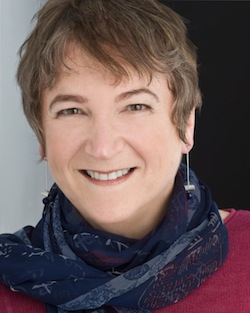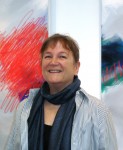“Running Again” by Joyce Ozier, part of her current exhibit at Fazakas Gallery. (image from fazakasgallery.com)
Chefchauen is a village in Morocco. Founded in 1471, it was home to many Jewish refugees escaping the Spanish Reconquista during medieval times. No Jews live in this village now and haven’t since the late 1940s, but this little tourist town in the Rif Mountains was the inspiration for Vancouver artist Joyce Ozier’s latest exhibit, Blue Refuge.
“I discovered Chefchauen by accident,” Ozier told the Independent. “Last year, while I was getting ready for my show at the Zack Gallery, I received lots of emails and newsletters. One of them mentioned Chefchauen, a blue town in Morocco, and included a few photographs. I was knocked out by the magic of its blue colors, but my first response was purely esthetic. I imagined how these different shades of blue – blue stucco walls, blue doors, blue roofs – would change throughout the day in the strong Mediterranean sunlight.”

After her initial fascination wore off, she became curious. What was the reason for the town being blue? “There was a one-line explanation for the unusual color: a group of Jews running from the Nazis in the ’30s painted the town blue in gratitude for it being a safe haven. After I read that line, I wanted to know their story,” she said.
Ozier started researching the history of those Jews who gave the town its charming blue attire, while simultaneously creating her own visual narrative – the nine abstract panels reflecting their intriguing story. But, while her artistic endeavors were successful, her research path was littered with disappointments. Nobody knew much or even anything about Chefchauen and its Jewish history.
Determined to learn all she could about the people who made the town blue, she embarked on a quest to understand those long-gone Jews. After various online searches, she tried the Isaac Waldman Jewish Public Library, but to no avail. “Then I found a Jewish tour company in New York that specialized in Jewish Morocco,” she said. “I called them, thinking that they would be able to answer my questions, but they had no idea either. Their advice was to try the Jewish museum in Casablanca, Morocco.”
She made the call and spoke with the museum’s curator, but still no luck. “By this time,” she said, “I decided to imagine my own version of what had happened, how those Jewish refugees got to Chefchauen, what they went through, why they decided to paint everything blue, and what happened after. Over the years, I’ve read many personal accounts of the Holocaust and, based on those, I wrote the texts for my show, the short write-ups on each of the nine panels that comprise the show.”
Ozier wrote about the hardships the refugees would have encountered on their flight from the Nazis, about their joy at finding a safe haven, and about why they painted the town blue.
“Blue is the symbol of divinity in Judaism, being the color of sky and ocean,” she explained. “Observant Jews are required to have a blue thread in their prayer shawls, so when they pray, they are enveloped in divinity. To express their appreciation for being alive, for being able to reach Chefchauen, the refugees painted the whole village in shades of blue. The divine blue created an environment that gave them the hope they needed to go on. It helped them stay positive in a terrifying and insecure political situation. It prodded them to resume relatively normal lives once they had settled in.”
Unfortunately, as soon as the Vichy government took over Morocco, the persecution of Jews started there, too. “Their safe haven was a dream,” Ozier wrote, and her panels follow the rest of the story, as most of the Jewish citizens of the blue town left. Nobody knows what happened to them, but Ozier hoped they had headed for Israel.
“My show was almost ready, but then I panicked,” she recalled. “I needed a confirmation for my fictional story. Was it based on fact, or even a possibility of fact, or was it just my imagination?” The Vancouver Holocaust Education Centre came to her rescue.
“Phillipa Friedland, the centre’s education coordinator, was wonderful,” said Ozier. “She had not heard of Chefchauen and its blue world but she was visibly excited to see the photos and hear my story. She suggested that I contact Yad Vashem, the Israel Museum in Tel Aviv, the Museum of Jewish People in Tel Aviv, the Leo Baeck Institute in Jerusalem and the Museum of the Diaspora at the University of Tel Aviv.”
One by one, Ozier contacted each of the leads Friedland gave her, but most of the institutions couldn’t help. Some only did family research. Others specialized exclusively in the war years. “I wrote an official request for information to Yad Vashem and got a response from them much sooner than I expected. Timorah Perel from their reference and information services explained to me that most of their testimonials are written in languages other than English and would require translation. She sent me the only English testimony that came up in her search in English. It was very interesting but it did not mention Chefchauen.”
Eventually, Ozier’s persistence paid off. She contacted Tel Aviv University. “The receptionist who answered the phone told me that they had a professor who specialized in the Jews of Morocco, Dr. Yaron Tsur. She gave me his university telephone number and his email address. Excited to have a real lead after all the dead ends, I immediately wrote Dr. Tsur a long email, explaining my upcoming show and including all my photos and my texts. I asked him whether he thought my story could be based on reality or it was a total fantasy.”
She received no reply, and no response to several phone calls. “Frustrated, I called the receptionist again, thinking perhaps I’d written down the wrong number. This time, she told me Prof. Tsur was in America. He was on sabbatical this year.”
Ozier finally was able to reach him. And Tsur confirmed her story, saying in an email that “the story of the Jewish refugees that you relate and the asylum that some of them found in Morocco is historically true.” She could go ahead with her show.
“They still paint the town blue,” Ozier said, “even though no Jews live there any longer. It’s a tourist attraction now, and the local government pays for the paint, so they could retouch it annually. One more little factoid I found in my research: the blue changes during the day, resembling running water. It repels mosquitoes.”
Blue Refuge is at Fazakas Gallery, at 145 West 6th Ave., until Dec. 17.
Olga Livshin is a Vancouver freelance writer. She can be reached at [email protected].


